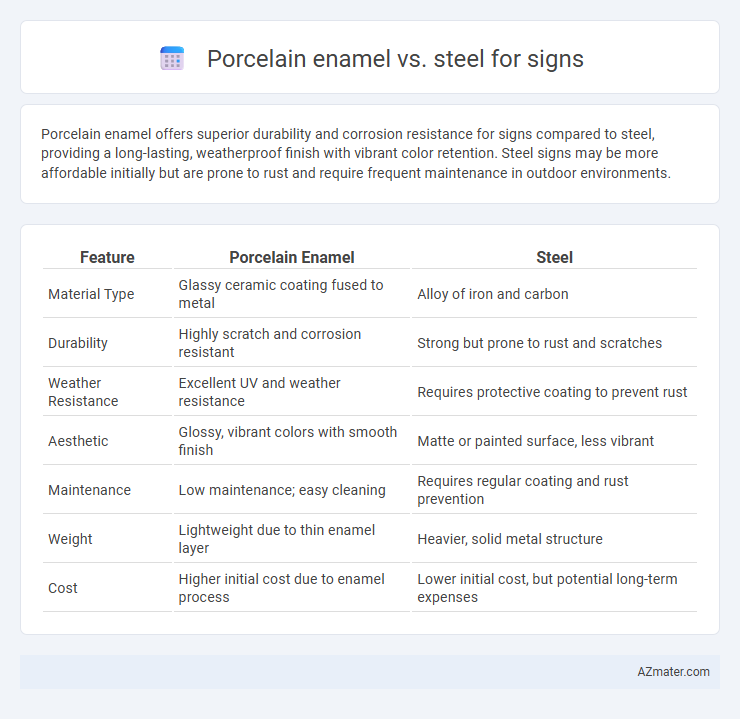Porcelain enamel offers superior durability and corrosion resistance for signs compared to steel, providing a long-lasting, weatherproof finish with vibrant color retention. Steel signs may be more affordable initially but are prone to rust and require frequent maintenance in outdoor environments.
Table of Comparison
| Feature | Porcelain Enamel | Steel |
|---|---|---|
| Material Type | Glassy ceramic coating fused to metal | Alloy of iron and carbon |
| Durability | Highly scratch and corrosion resistant | Strong but prone to rust and scratches |
| Weather Resistance | Excellent UV and weather resistance | Requires protective coating to prevent rust |
| Aesthetic | Glossy, vibrant colors with smooth finish | Matte or painted surface, less vibrant |
| Maintenance | Low maintenance; easy cleaning | Requires regular coating and rust prevention |
| Weight | Lightweight due to thin enamel layer | Heavier, solid metal structure |
| Cost | Higher initial cost due to enamel process | Lower initial cost, but potential long-term expenses |
Introduction to Porcelain Enamel and Steel Signs
Porcelain enamel signs consist of a durable glassy coating fused to a steel substrate, offering exceptional resistance to weather, corrosion, and fading, making them ideal for long-lasting outdoor signage. Steel signs, while robust and versatile, lack the protective enamel layer, which can lead to rust and wear over time if not properly treated or maintained. Porcelain enamel provides superior color retention and a smooth, glossy finish that enhances visual appeal and durability compared to traditional steel signage.
Material Composition: Porcelain Enamel vs Steel
Porcelain enamel consists of a glassy coating fused onto a steel substrate, combining the durability of steel with a smooth, corrosion-resistant surface ideal for long-lasting signage. Steel, composed primarily of iron and carbon, offers high tensile strength and structural integrity but lacks the inherent weather resistance provided by porcelain enamel coatings. The fusion of silica, fluxes, and metal oxides in porcelain enamel creates a hard, vibrant finish that enhances steel's performance in outdoor sign applications.
Durability and Weather Resistance
Porcelain enamel offers superior durability for signage, with a glass-like coating that resists corrosion, UV rays, and extreme weather conditions, ensuring long-lasting vibrant colors and minimal fading. Steel signs, while strong and impact-resistant, are more prone to rust and require protective coatings to withstand moisture and harsh environments effectively. For outdoor signage exposed to fluctuating weather, porcelain enamel provides enhanced weather resistance and maintains structural integrity better than untreated or standard steel.
Visual Appeal and Aesthetic Longevity
Porcelain enamel offers superior visual appeal for signs with its glossy, vibrant finish that resists fading and corrosion over time, maintaining its aesthetic integrity even in harsh weather conditions. Steel signs, while sturdy and cost-effective, often lack the rich color depth and long-lasting gloss of porcelain enamel, leading to more frequent touch-ups or replacements to preserve appearance. The durability of porcelain enamel ensures a visually striking sign that sustains its professional look and color vibrancy for decades.
Maintenance and Cleaning Requirements
Porcelain enamel signs offer exceptional durability with a non-porous surface that resists scratching, fading, and corrosion, making them easy to clean using only mild soap and water without specialized cleaners. Steel signs require regular maintenance to prevent rust and corrosion, often needing protective coatings and more frequent cleaning to maintain appearance and longevity. The low maintenance and high resistance properties of porcelain enamel make it a preferred choice for long-term, weather-resistant signage.
Cost Comparison and Long-Term Value
Porcelain enamel signs generally have a higher upfront cost compared to steel signs due to the materials and labor-intensive firing process, but they offer superior durability and resistance to weathering, chipping, and fading. Steel signs, while more affordable initially, may require frequent maintenance, repainting, or replacement over time, impacting long-term value. Investing in porcelain enamel signage often results in lower total cost of ownership with enhanced longevity and sustained aesthetic appeal.
Customization and Design Options
Porcelain enamel signs offer vibrant, long-lasting colors with intricate graphic details due to the high-temperature glass coating process, making them ideal for custom designs that require durability and a glossy finish. Steel signs provide versatile customization options through various paint finishes and cutting techniques, allowing for tailored shapes and textures but may lack the same depth of color vibrancy and resistance as porcelain enamel. Choosing between porcelain enamel and steel depends on the desired lifespan, color fidelity, and complexity of the sign's design elements.
Environmental Impact and Sustainability
Porcelain enamel signs offer exceptional durability and resistance to weathering, reducing the frequency of replacement and minimizing waste over time. Steel signs, while recyclable, may require coatings that can emit volatile organic compounds (VOCs) during production, impacting environmental sustainability. The long lifespan and low maintenance of porcelain enamel contribute to a smaller carbon footprint compared to steel signs with shorter replacement cycles.
Typical Applications for Each Material
Porcelain enamel signs are typically used in outdoor environments requiring high durability and resistance to weather, such as vintage advertising, street signs, and industrial labels, due to their corrosion resistance and vibrant color retention. Steel signs, often galvanized or coated, are preferred for temporary or construction signage, industrial warning signs, and areas demanding impact resistance and ease of fabrication. Both materials serve distinct roles based on environmental exposure and longevity needs, with porcelain enamel excelling in long-term outdoor visibility and steel favored for strength and cost-effectiveness.
Which is Best? Choosing the Right Sign Material
Porcelain enamel offers exceptional durability, resisting weathering, fading, and corrosion, making it ideal for long-lasting outdoor signage with vibrant colors. Steel signs provide strength and affordability but may require protective coatings to prevent rust and wear over time. Choosing the right sign material depends on the intended usage, budget, and desired lifespan, with porcelain enamel preferred for premium, enduring displays and steel suited for cost-effective, versatile applications.

Infographic: Porcelain enamel vs Steel for Sign
 azmater.com
azmater.com